Get Your Agile and Integrated Procurement Cycle
How to survive managing the IT asset purchase cycle in your company with just a few key elements that ensure a just-in-time approach and decreased waiting time
What are the goals and benefits of automating the procurement process?
Sooner or later, it’s going to be time to change and evolve. It’s usually better to choose ‘sooner,’ especially when it comes to IT, or technology in general.
Typically, determining which aspects to improve can be challenging, but investing time and resources in these areas is crucial. However, investments in effort aimed at improving processes, communication, and data management in a company always bring significant value, regardless of the company’s size.

Purchasing materials, especially in the IT sector, is a complex and risky process. Maintaining large warehouses and inventories is costly, and managing obsolescence due to frequent technological change is a constant risk. To mitigate these risks, it’s important to have a well-planned procurement process. And so there’s a growing emphasis on models that provide the desired devices (or software, or licenses, or etc.) “just in time” before they’re needed.
Automating the procurement process enables the implementation of just-in-time concepts, avoids no-value activities for people, and ensures comprehensive tracking of all aspects of the process. Additionally, it promotes alignment among all parties involved regarding the status of orders and receipt of goods.
This article provides an example of how to handle this task in a straightforward manner. Everything begins with a strong underlying design, a reliable database, and the implementation of a few basic automation rules.
What elements must be aligned to accomplish this?
As always, I recommend beginning with a solution design that’s built with the appropriate criteria. Reasoning on paper and sketching out the solution can be a big help at this stage to identify improvements and enable the exchange of ideas among team members.

That said, since in this article we’ll be exploring ways to handle the entire IT procurement process, we’re certainly not dealing with a topic that’s easy to manage. Think for instance about the different ways we can get materials and all the different people involved (users, IT team, buyers, suppliers, logistics, etc.). To get an idea of how complex it is, you can check out how contracts and procurement are approached by the PMI (Project Management Institute) by reading these articles: Article1: A project procurement vision statement – Article2: Managing a procurement and the associated risks.
Due to the required format standards, we won’t address a complex case. However, it will still be comprehensive in terms of the practicality and robustness of such solutions.
Please remember that to enable automatic assistants (including in the procurement process), a solid and consistently updated database is necessary. Without it, users can’t trust the output of automated agents. Even the most sophisticated and powerful automated system cannot deliver added value while producing trustworthy results.
Now let’s look at our solution as it was conceived on paper. This is the “big picture” of the complete procurement cycle of an IT asset, starting from when the need arises (such as a new employee hired by the company) to when the goods are delivered to the user. In between, as we’ll see later, many actors and several sub-processes will be involved; in addition, several automated tasks will be activated along the way to support users and ensure the robustness of the data.
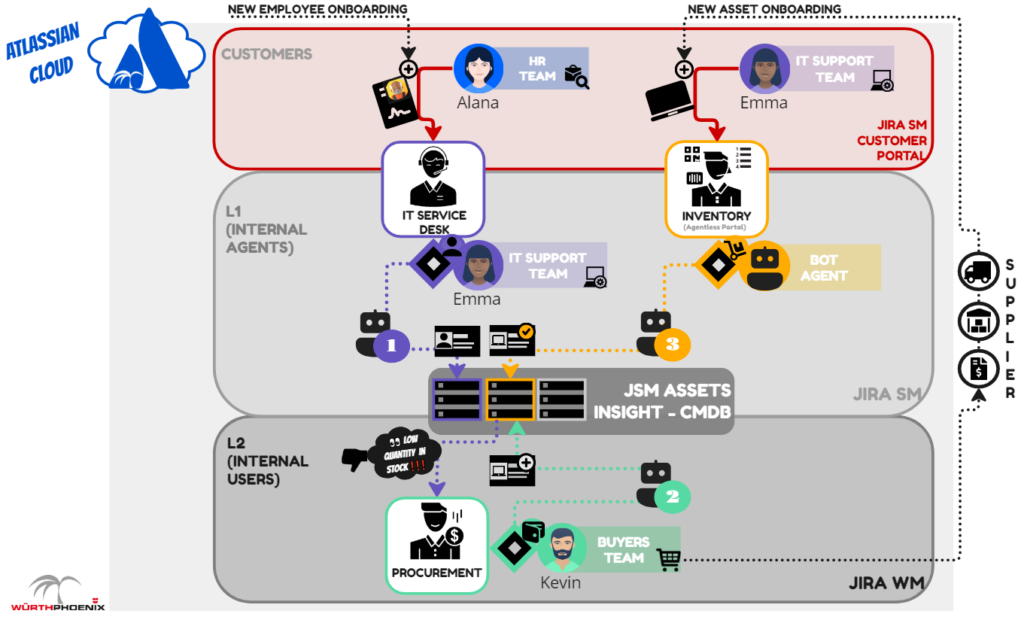
Since the big picture above, although a simplified representation of reality, is still rich in elements, let’s look at what these elements represent to make everything more comprehensible. Afterwards, we’ll analyze each step of the process in detail.
Assets in the JSM Assets CMDB
In the central part of the big picture, there are JSM Assets. This container holds much of the data needed to complete the process. JSM Assets typically integrates with third-party systems, but can also be used stand-alone.
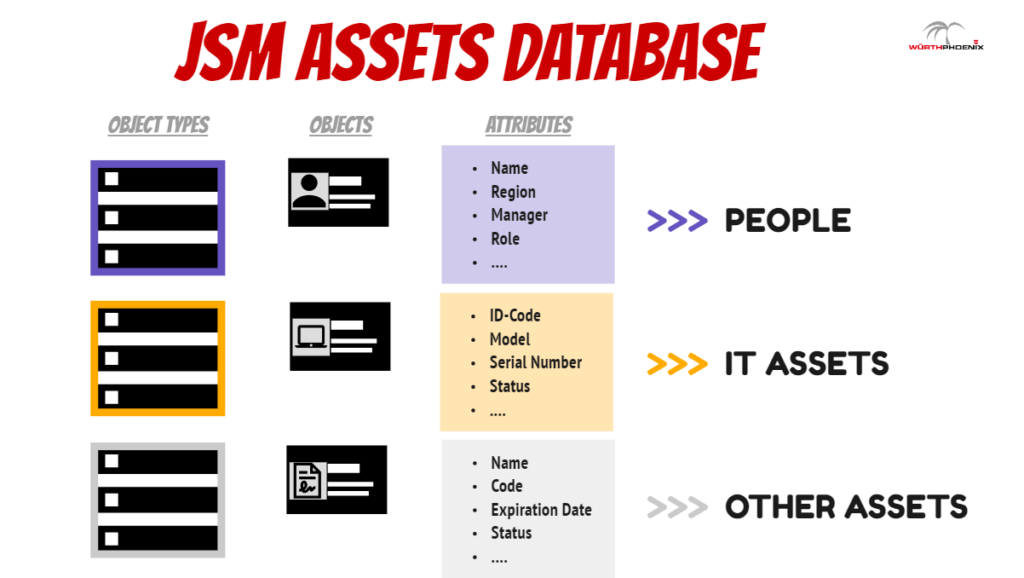
It’s important to build clear, orderly, and scalable structures to host the data, whether it synchronizes with other systems or is managed locally.
For managing the company’s employee records and IT assets, we’ll use two Object Types: People and IT Assets. Each Object Type has its own set of defined Attributes (fields), which will be inherited by every Object created within them.
JIRA Projects for teams and even agentless
In order to ensure the status tracking of all activities and sub-processes that are generated, you need to equip the people involved with a tool for managing shared work. In this case, we have 3 Jira projects managed by two teams (IT support and buyers).
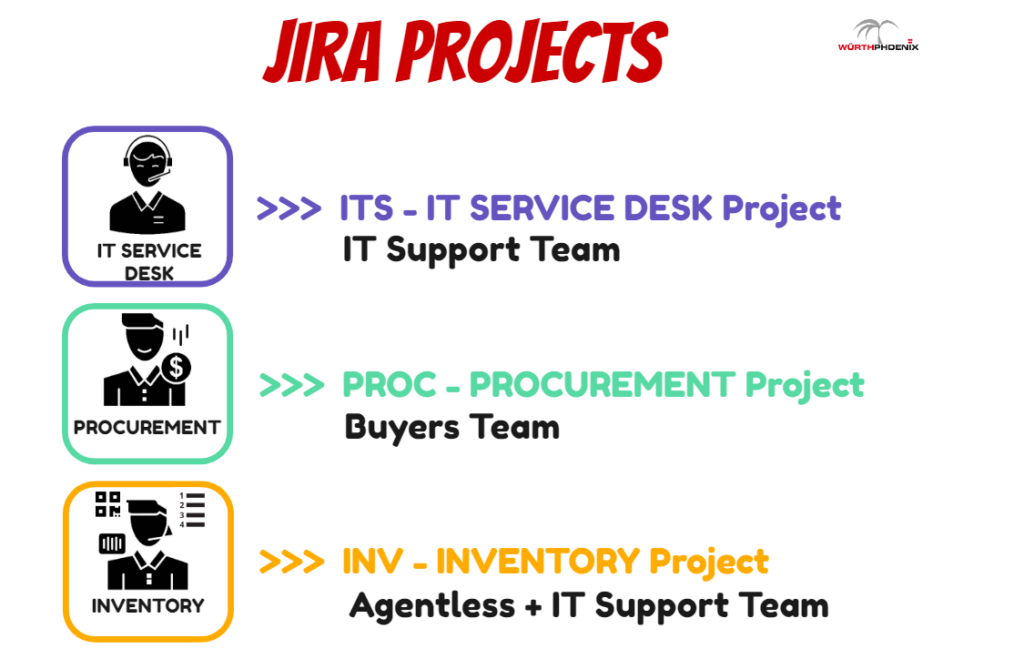
Note that Inventory is an agentless portal for many request types, meaning it has a high degree of automation, so that some requests are completely processed without the need for a human agent.
Jira Issues
As per the definition, complex work should be simplified by breaking it down into smaller, more manageable elements. In this case, we’ll need three Jira issues that represent the 3 macro phases of this process and will provide us with an overview of the progress of the procurement of a given device.
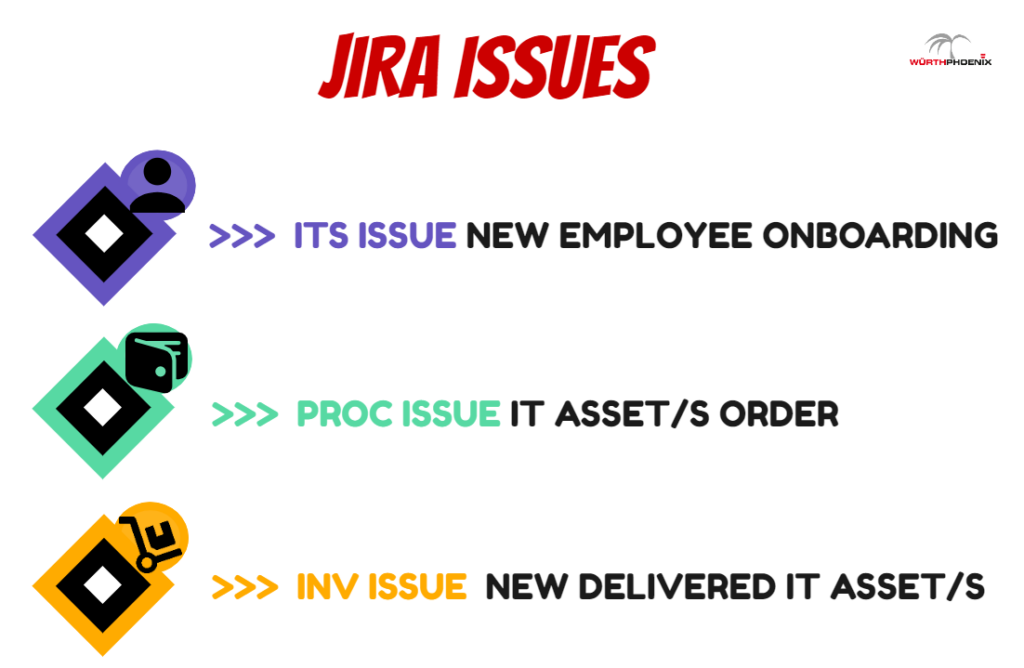
The ITS issue, created by Alana from the HR team and managed by Emma from the IT Support team, will be used to report the arrival of a new resource in the company along with its related information. In case of a shortage of parts in stock, the PROC issue will be used to track the process of evaluating, approving, and ordering material by Kevin from the Buyers Team.
Finally, when the material physically arrives at the company, the INV project issue will be created to manage the remaining information.
Automation
As the final crucial component of the big picture presented above, we now introduce the automation involved. These represent the engines that support users throughout the process and securely brings the data into JSM assets.
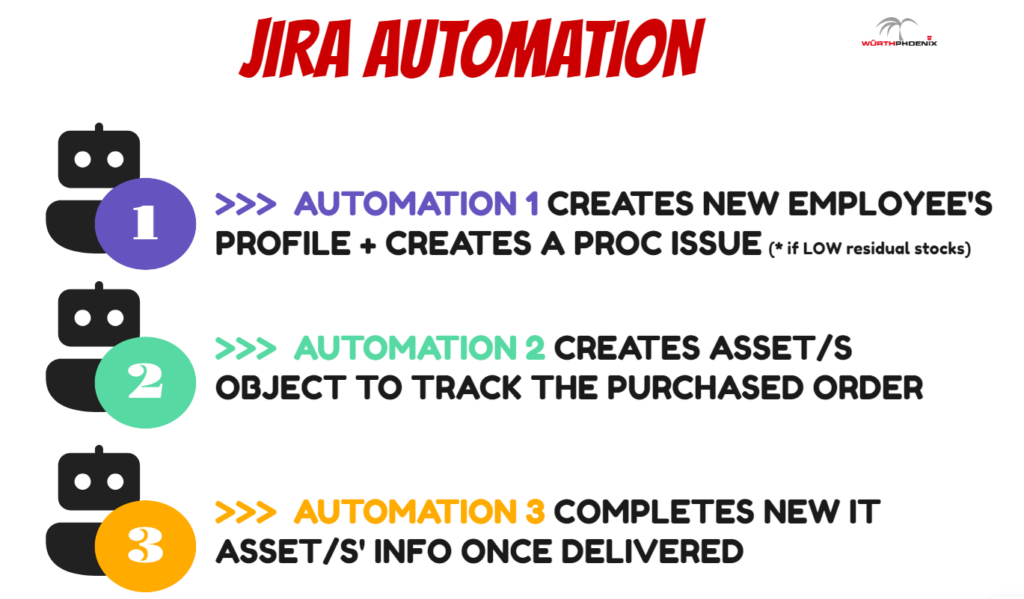
There are three of these automations that coincide with the three phases previously mentioned for Jira issues. Later, we’ll delve into the details of how they function and the tasks they complete in support of the entire process.
Below I’ll also introduce other crucial elements, which are the people and teams involved, but for now let’s focus on other more high-level elements.
Before analyzing the individual steps and elements of our example process, it’s crucial to understand that the elements presented are key building blocks.
- JSM Assets represent the solid database to cement the foundation of the process
- Jira projects and the tool itself represent the perimeter within which all teams can communicate and collaborate with each other
- Jira Issues and their associated workflows represent the phases of the entire lifecycle, already broken down into modular requests that can be selectively activated, thus reducing overall complexity
- Automations embody the concept of “automating as much as possible“, derived from an ITIL guide principle
Having defined what the fundamental elements are, now let’s examine the steps of the use case in detail. This will show how a procurement management process is accomplished.
Let’s see the automated procurement process at work
As is evident from the Big picture presented before, there are many steps involved. So I’ll describe them concisely to highlight the overall value of the solution without delving into excessive technicalities. In the future, we may offer articles dedicated to the individual components we’re discussing today.
Step 01 – HR team involves IT support since a new colleague is about to join the company
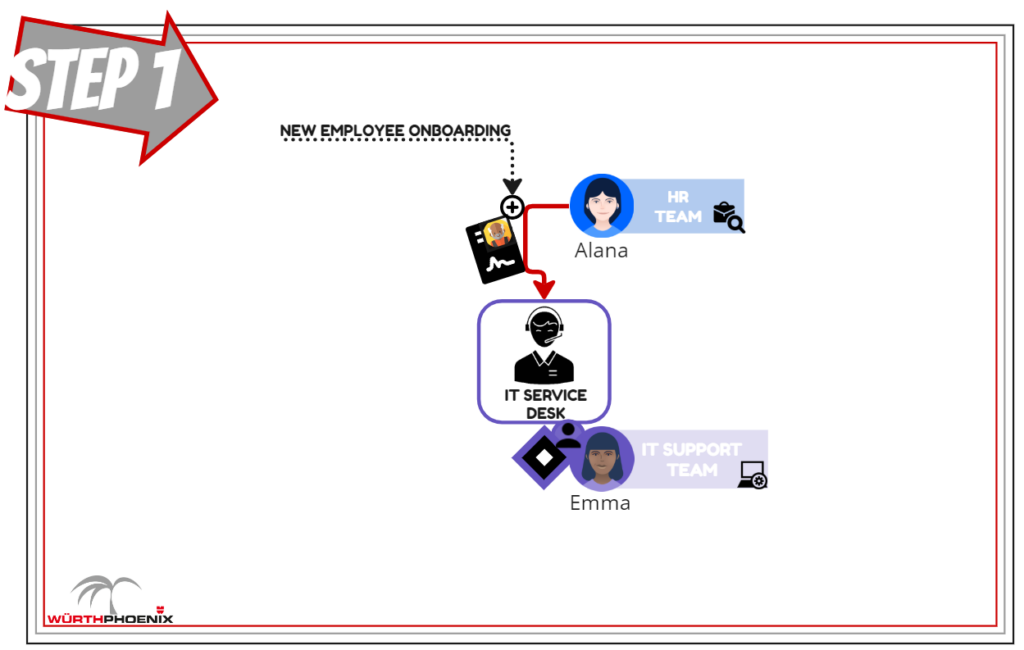
Alana from the HR Team raises a “Setup new Employee” request to the IT Service Desk from the customer portal. The required fields to activate the IT team were already prompted to her by the system at this stage.
The Information to be provided by her are:
- Summary
- Employee Department
- Employee Manager
- Employee Role
- Region
- Office
- Employee Equipment Needed > [Yes] OR [No]
After completing the information she sends the request to the IT support team.

Step 02 – The Automation 01 gets in action and Emma check the result
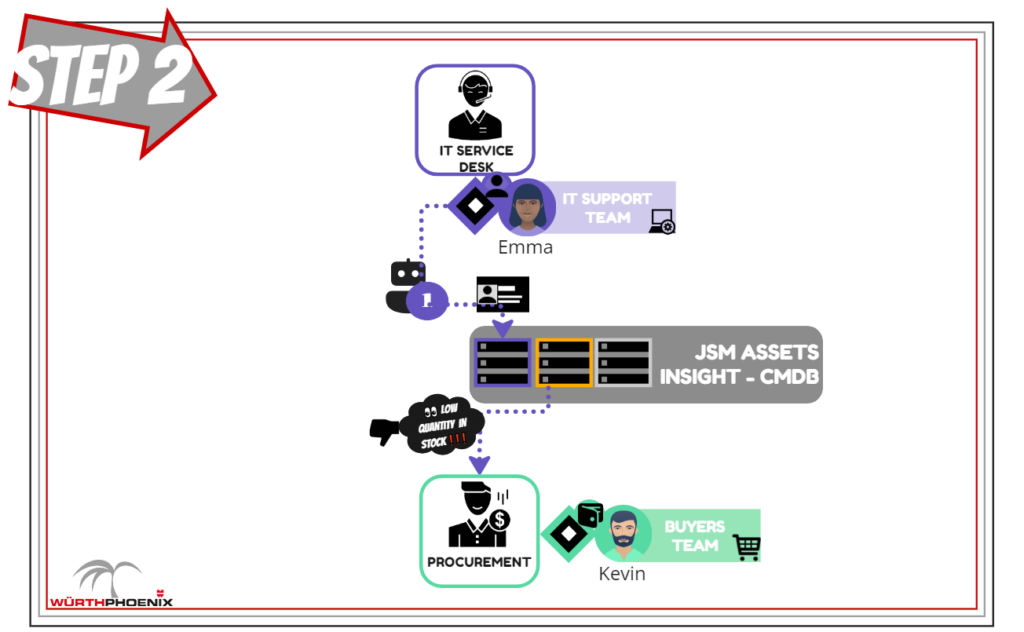
After the request is submitted, Automation 01 begins working immediately, even before an agent reviews the request. Below are the actions it takes before passing the task to Emma by assigning the issue to her.
To begin, the Automation for Jira will create an Object in the People assets’ scheme.
It populates the new user attributes by copying the original information provided by Alana.
This object will be reused multiple times (twice just in this procedure) for a wide variety of reasons, and so it’s important to have it available as soon as possible in the CMDB.
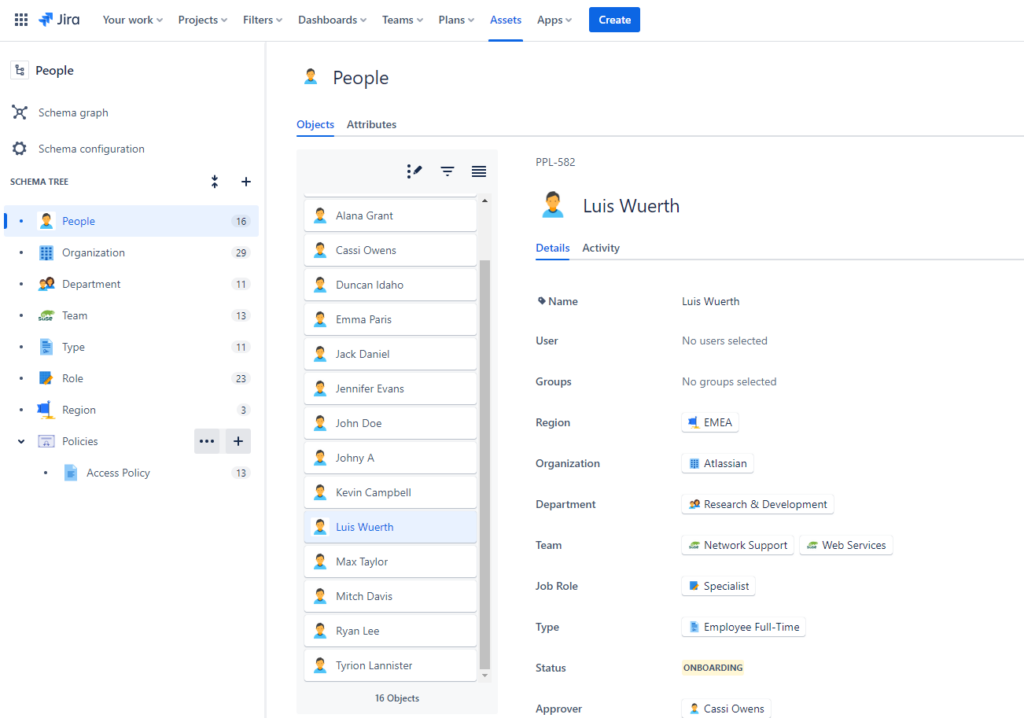
Then, Automation 01 checks the CMDB to determine which devices are pre-authorized for the “Specialist” profile level listed in Alana’s request, attributed to Luis.
.
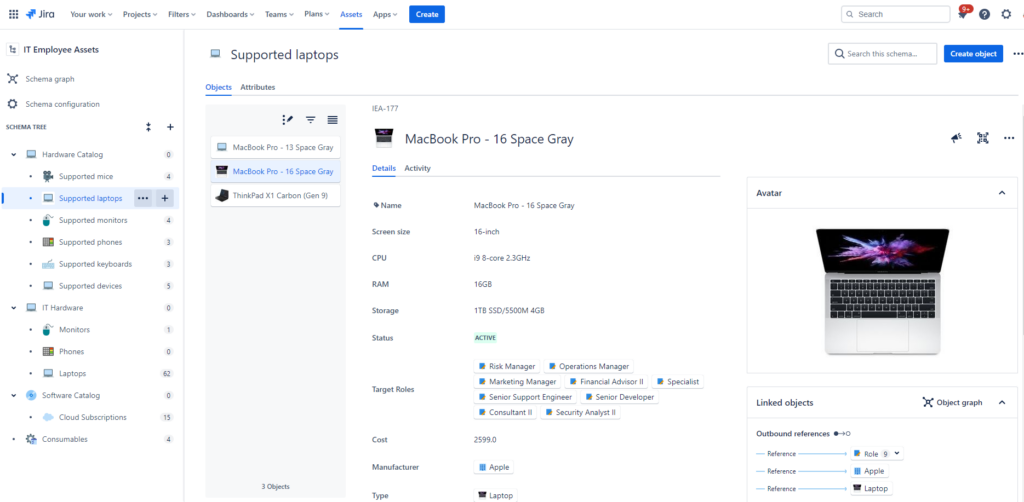
The same automatic search and association based on the new employee’s profile can be applied to other IT-related aspects, such as software installation on the PC and licenses for business applications on cloud plans. This is how any association of “Target Profile A –> asset X” and “Target Profile B –> asset X + asset Y” can be handled, not just for IT assets.
Automation 01 performs a crucial task to complete its work. It verifies that the device allocations for the new collaborator, Luis, do not reduce the stock of these devices in the warehouse below the minimum thresholds.
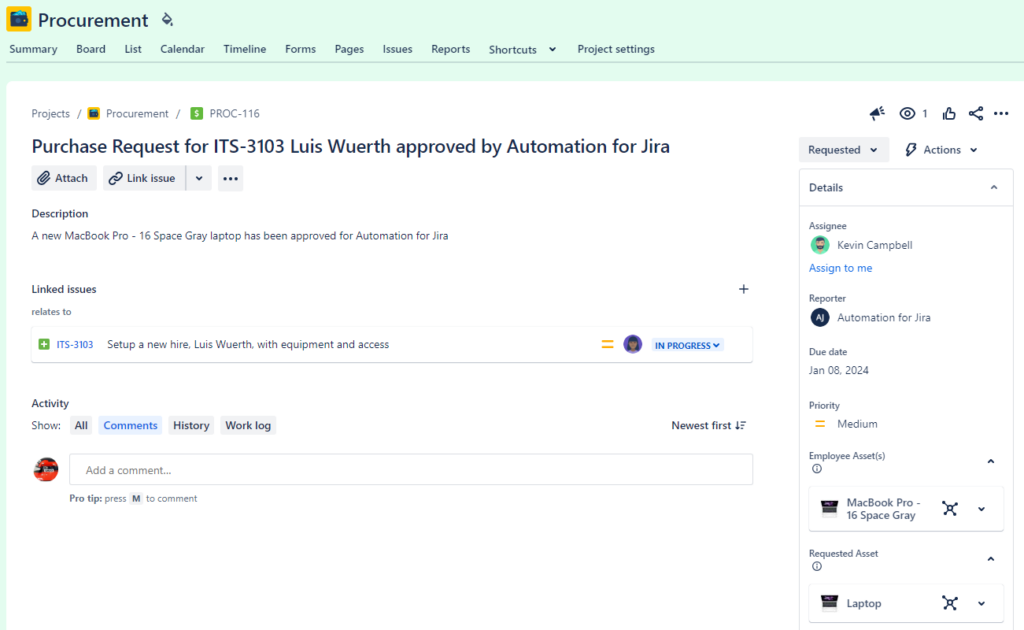
If the remaining stock is insufficient, Automation 01 creates an issue in the Procurement project to indicate the need to purchase the product. Kevin from the Buyers team is automatically assigned to the issue once created.
When completing Step 2, the effects of automation on the ITS issue become visible. The image on the right shows the assignment of the newly created user’s profile within the CMDB at the bottom, while the right column clearly displays the association to the target model for Luis’s profile. Moreover, if there isn’t enough material in stock to fulfill the request, Emma can monitor the “linked issue” created by our automated task in the Procurement project.
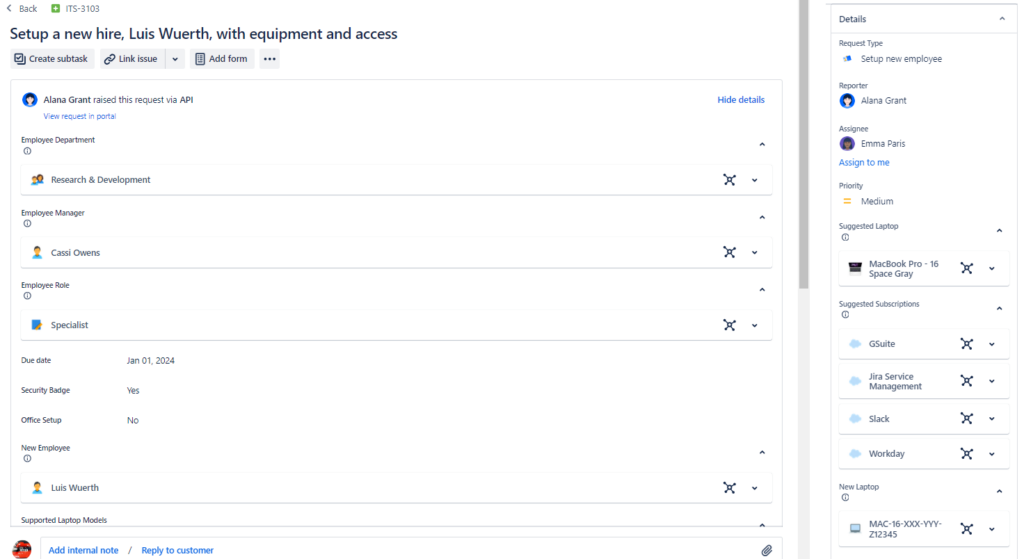

Step 3 – Procurement purchases the order while Automation 02 aligns the CMDB accordingly
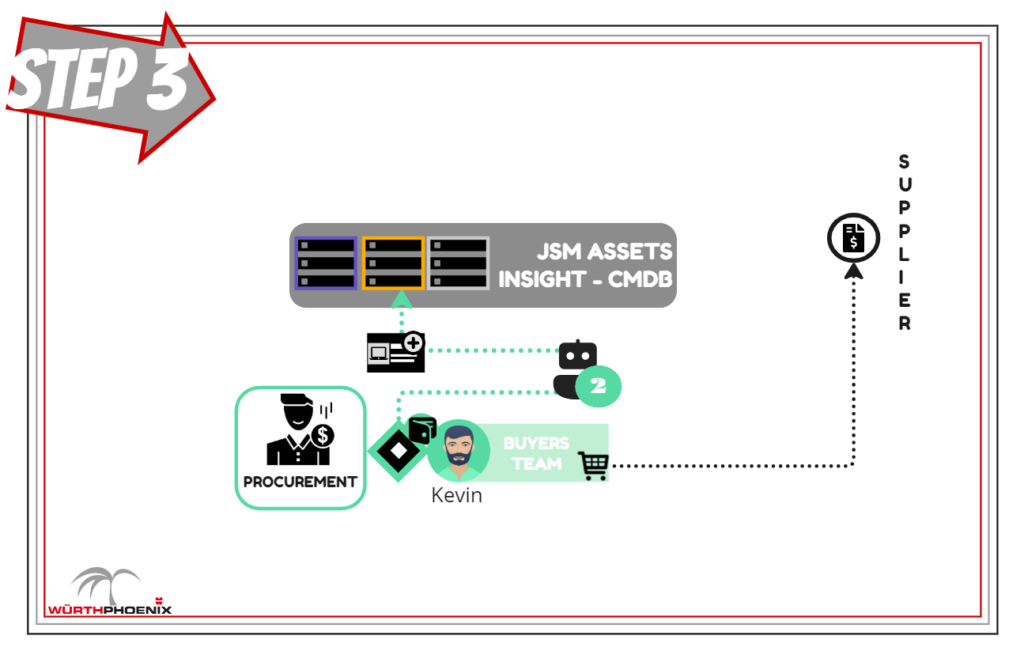
The Procurement project has an issue type called Order. It has a dedicated workflow for handling such requests, which can be seen in the picture to the right.
When Kevin places the order to the supplier and transitions the issue “Order” to the last workflow status, which is “Purchased“, Automation 02 will be triggered. Its task is to create a placeholder object in the CMDB with the available information and with the attribute “Status” set as “On Order”. This object will be completed later, only upon physical delivery of the notebook.
Finally, Automation 02 completes its work by associating the new placeholder object with the PROC issue, making this visible to Kevin from a dedicated custom field, called “Associated Laptops“.

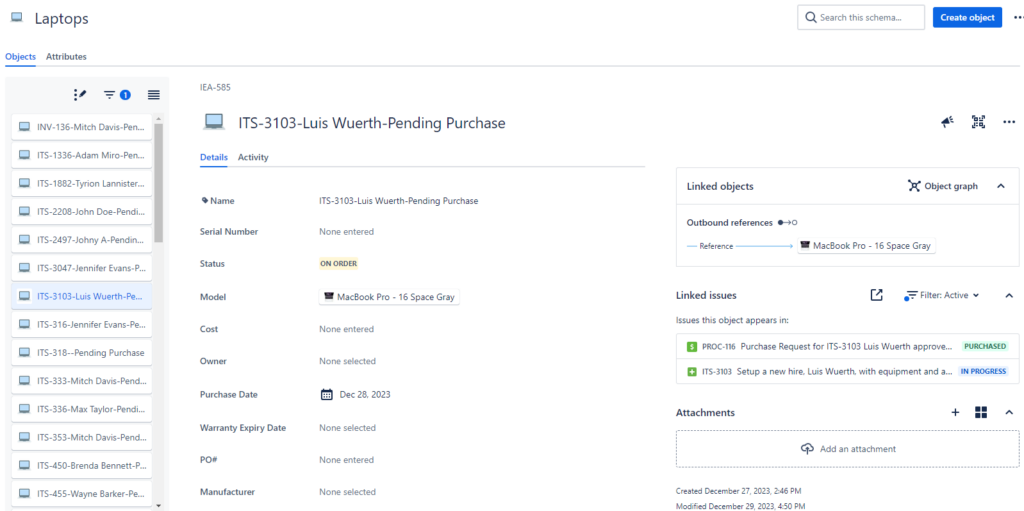
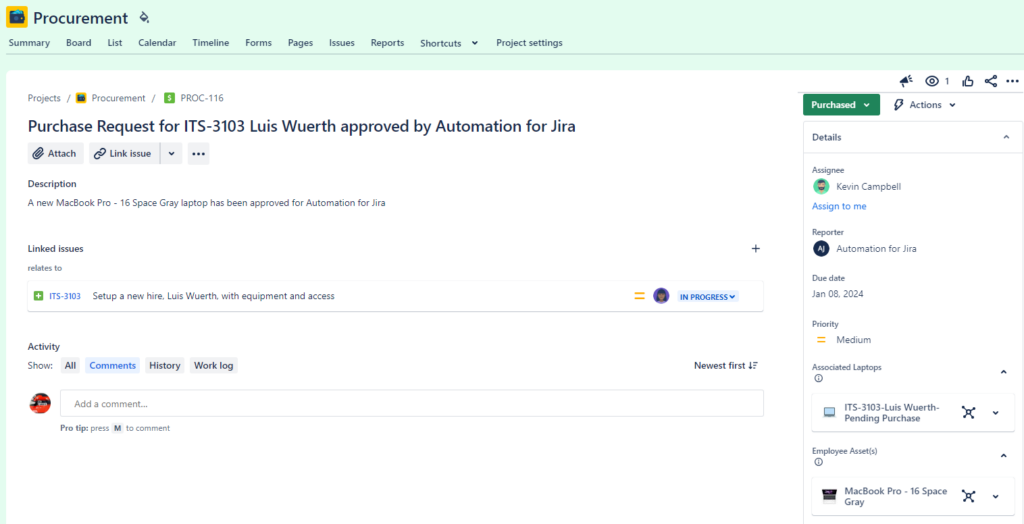
Internal users like Kevin or Emma can manage asset information in the CMDB even if it’s not physically available, or scheduled for delivery later. Note that if the company requires a device, its object will be created in the CMDB, even if the device is not yet present. This enables tracing the asset’s history back to its original reason for purchase.
Step 4 – Emma receives the device and creates an issue in the Inventory project from a dedicated JSM portal
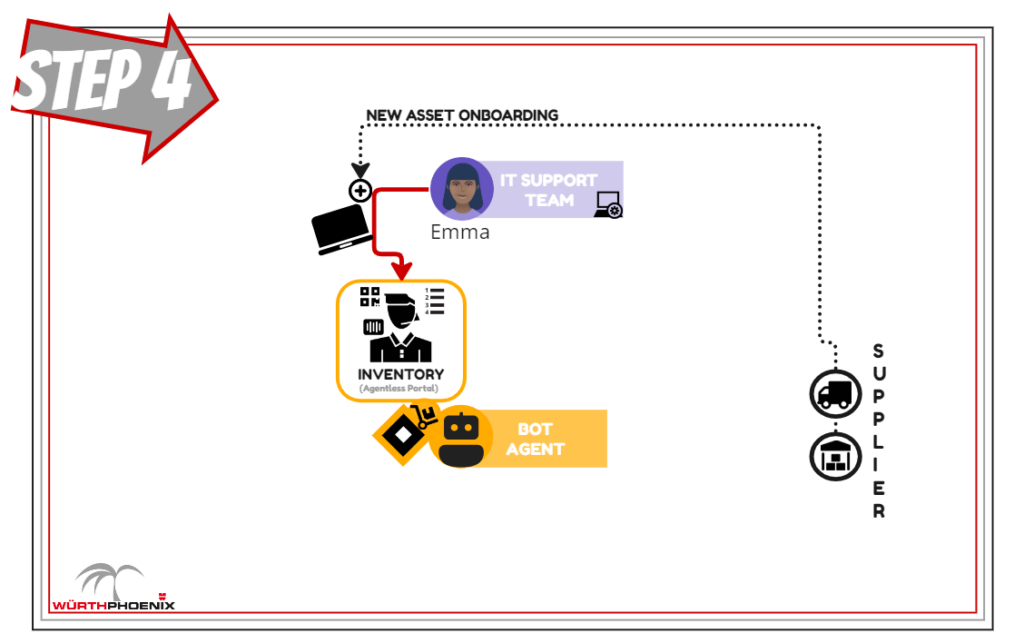
Emma, the recipient of the goods, opens an “Update laptop details” request on the Inventory Management Portal after receiving the new notebook from the supplier.
She fills in all the fields with the information now available from the notebook (remember that we have just created a placeholder with a few basic information before), which is now physically present and ready to be configured and delivered to her new colleague, Luis.
Directly from here, Emma assigns the newly arrived device to Luis, even though she will have to complete the configuration later. After eventually configuring and handing it over to Luis, Emma can update the asset’s information from here again .

Step 5 – Automation 03 stores updated information provided by Emma in the existing notebook’s placeholder object
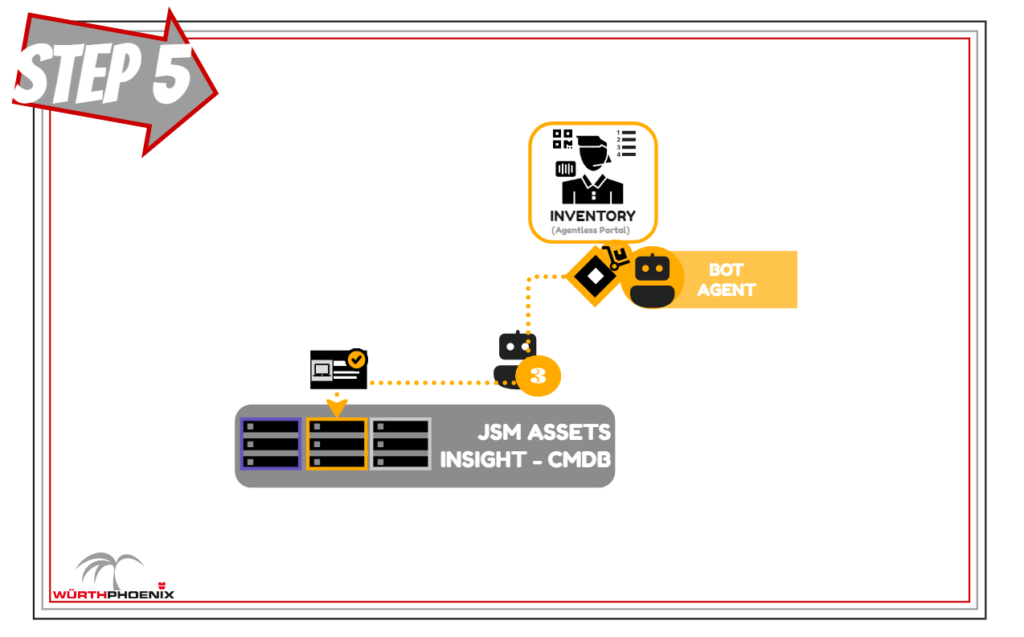
In this final step, Automation 03 performs almost every action completely by itself, which is why this portal is referred to as “agentless“, although Emma still initiates the action by clicking ‘send request’ in the previous step.
Moments later, the newly opened request is closed and a comment is added to confirm its success. These actions were performed by Automation 03 during the creation of the request itself.
Finally, Automation 03’s most important task consists of updating the previously created notebook placeholder object into the CMDB with all the information provided by Emma in the previous step.
This will ensure that all information related to the specific notebook is consolidated in one place. The acquisition purpose, ordering process, and current owner of the item should be clearly specified into the notebook object.

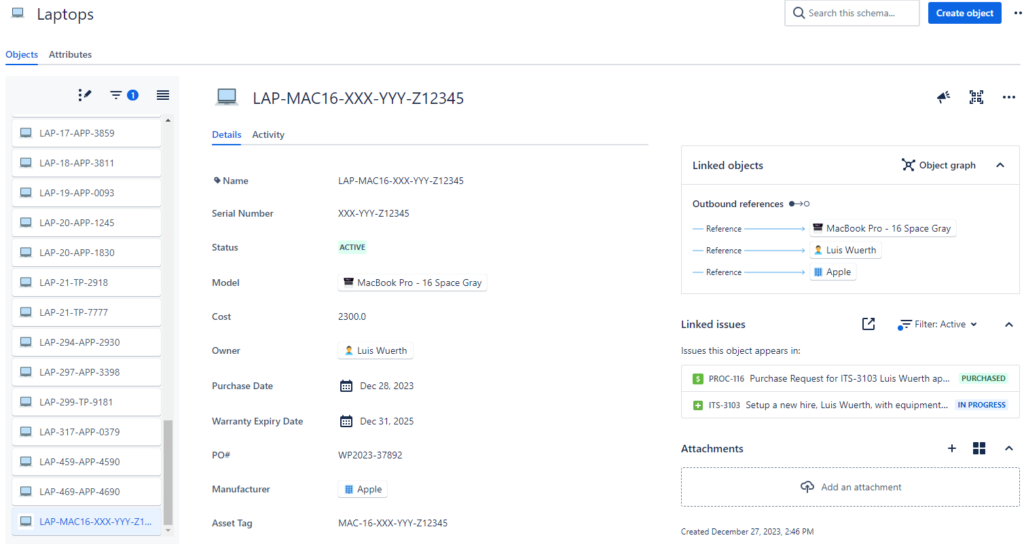
Conclusions
This article tries to convey the idea that even the most complex processes can be simplified and managed effectively, exactly as the procurement task can be. The transition to simplicity can be challenging, but it is achievable. Initially, the process may seem daunting, and even the simplest goals may appear quite distant. It’s important to maintain focus on the base processes, even in material procurement, and take advantage of opportunities where automation can streamline work and strengthen the database.
Finally, we encourage you to consider your own use cases and evaluate the potential benefits of implementing these solutions in your specific situation. While it may seem like science fiction at times, we assure you that it’s not at all.
This concludes our discussion for now. I look forward to seeing you again in upcoming posts.
See you in the next episode….
These Solutions are Engineered by Humans
Did you find this article interesting? Does it match your skill set? Our customers often present us with problems that need customized solutions. In fact, we’re currently hiring for roles just like this and others here at Würth Phoenix.






